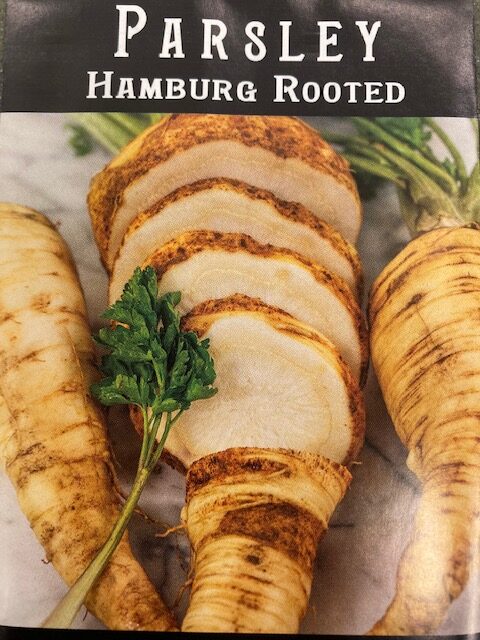
Parsley Root
Parsley brings a fresh bright flavor to dishes and is often used as a garnish. The rooted parsley is a great root crop perfect for soups and stews.
|
Hamburg Rooted |
|
Petroselinum crispum |
|
Intermediate to Easy |
|
Intermediate |
|
2-3 years if properly stored |
|
Biennial |
|
can take 3 weeks or more |
|
Cold stratify for 4 weeks Optional: Soak overnight |
|
Surface Sow |
|
Full sun to part shade |
|
3-4 months |
|
Feb, Mar, Aug, Sep |
|
Yes |

Growing Tips




When to Start
Spring: Do 4 weeks of cold stratification and then direct sow 6-8 weeks before the last frost (which is February/March for GA). Keep in mind not to plant too late, as a later planting will reduce the size of the root.
Fall: Direct sow in mid-fall. (Aug-Sep for GA.)
How to Grow
Before direct sowing or starting indoors, cold stratify the seeds for 4 weeks. Do this by placing the seed packet in the refrigerator.
Transplanting for parsley root can be done, but it needs a bit of care. If you choose to transplant, start indoors 6-8 weeks before the last frost but after the cold stratification period. Using biodegradable pots is best, as this will have the least amount of root disturbance. Otherwise, direct sow in early spring.
Keep in mind, parsley root needs a long growing season. While parsley root is frost-hardy, row covers or mulch might be needed to protect against any frosts or freezes.
For fall planting, direct sow seeds mid to late fall.
All parsley typically has a slow germination rate, which can take up to three weeks or more. An option to aid germination is to soak the seeds overnight. When planting parsley root, simply sprinkle seeds on top of the soil and mist well with water. Keep the soil moist throughout the germination process. Plant in full sun to partial shade in well-draining soil.
Be sure to remove any rocks from the soil so the roots will grow straight. Once the seeds have sprouted and have grown to 3-4 inches tall, thin them down to only one or two plants per pot or to 3-6 inches apart. Keep the soil moist throughout the growing season, as dry soil can lead to the roots splitting.
All parsley is container-friendly; for rooted parsley, use at least a 25” deep pot as the roots CAN grow 15-20” long. Place 3-6 plants in each pot.
How to Harvest
Leaves can be harvested like regular parsley leaves throughout the growing season. The root is ready 3-4 months after planting. But can be harvested once it reaches 4-5” long. Parsley root will have a sweeter flavor if it experiences a frost before harvest. It is possible to leave them in the ground until the first frost. There is a danger with this, however. Parsley root doesn’t like the heat. It can bolt or even die if it gets too hot. Try planting where it will get more shade and keep the soil moist but not soggy during the summer months. Mulch will also help keep the soil cool.
Another way around this is to plant in the fall and harvest during the winter. As rooted parsley is good for soups, winter is a good time to harvest!
While parsley root is a biannual, it is treated like an annual since it is the root that is harvested. To get seeds, don’t harvest the plant. Let it bloom, which it will do in the second year. See “How to Save Seeds” below for more details.
How to use
Parsley root is good in soups and can be treated like a parsnip. It can be roasted and used in homemade stocks.
Seed Saving

Isolation Distance
Insect-dependent and biennial, parsley can cross other parsley varieties and should be separated by 1 mile for reliable distance isolation. Allow seeds to mature and dry on the plants before harvesting.
Instructions
Plants will bloom in the 2nd year by sending up stalks to 2-3′ tall bearing compound umbels of greenish-yellow flowers. Unfortunately, leaves lose good flavor in the second year when plants are in flower.
Once pods or husks have been harvested, store them in a dry place and wait until they are thoroughly dry. When the pods or husks are dry enough they will easily crumble between your hands. Crumble the pods or husks until all the seeds are released.
Seeds and finer chaff are easy to separate by a variety of methods. One way is to use two screens of varying mesh, one a little smaller than the seeds and the other a little larger. The first screen lets anything smaller than the seeds fall through, and the second lets the seeds through and stops anything larger.
Features
- Parsley root: Heirloom. A winter root vegetable that is good in soups, stews, and roasted.

Parsley is biannual and will flower in the 2nd year. The leaves will lose their flavor during seed production.
To keep a continual supply of fresh parsley and fresh seeds every year:
- Keep enough space open for this year’s new seedlings.
- Once the 2nd year’s parsley seeds have been harvested, remove plants to make room for next year’s seedlings. This space will remain open for the next year’s seedlings.
- Keep the cycle going!
Try planting rooted parsley in part shade if you want to wait until a fall frost to harvest.
Parsley root seeds can benefit from cold stratification. If you are struggling to get seeds to germinate, try placing the seeds in the refrigerator for a few weeks. Then follow the above planting instructions.
Sources:
rareseeds.com
savvygardening.com
en.garden-landscape.com
Helmer, Jodi. Growing Your Own Tea Garden: the Guide to Growing and Harvesting Flavorful Teas in Your Backyard. Fox Chapel Publishers International Ltd., 2019.
